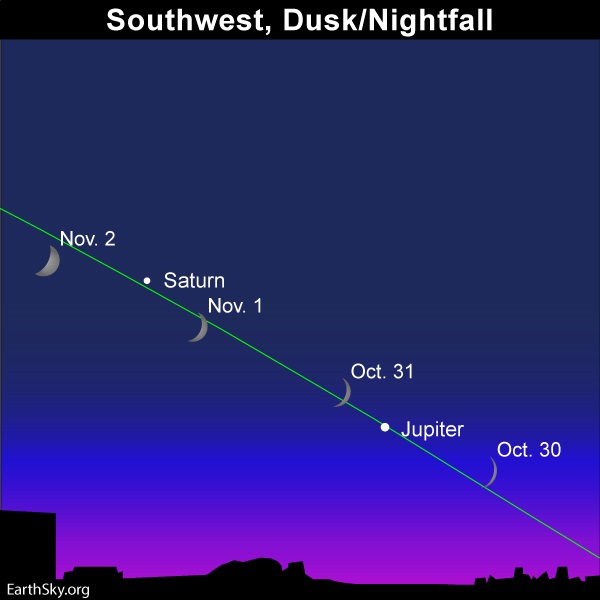The young moon will return to the evening sky this week. Will you see it? That depends in part on when you look, and on where you live on the globe. A young moon is one just after the new phase. It’s a thin crescent seen in the west after sunset. This month’s new moon comes on October 28, 2019, at 03:38 UTC; translate UTC to your time. After that time, the moon will be waxing, visible in the western twilight. It’s good to be mindful you’ll spot the young moon after sunset with more ease on October 29 than on October 28 … and with even greater ease by October 30 or 31.
All else being equal, a young moon is easier to spot on a spring evening than an autumn evening. That’s because the tilt of the ecliptic – the moon’s approximate monthly path in front of the constellations of the zodiac – is steep to the sunset horizon in spring but shallow in autumn. It’s now spring in the Southern Hemisphere and autumn in the North Hemisphere, so normally the Southern Hemisphere enjoys the advantage for spotting an October young moon. Yet, this October new moon is nearly at its maximum distance north of the ecliptic, which pretty much cancels out the Southern Hemisphere advantage and the Northern Hemisphere’s disadvantage.
EarthSky 2020 lunar calendars are available! They make great gifts. Order now. Going fast!

Moon on October 28. It’s difficult to catch any young moon that’s less than one day (24 hours) after new moon, and nearly impossible to spot one that’s less than 18 hours after new moon. So your east-west location counts, too, especially on October 28. On that date, by the time that sunset comes to the West Coast of North America, the moon will be 21 hours old, that is, 21 hours past new moon. You’ll have a better chance of spotting the young moon on October 28 from the North American Pacific Coast than at more easterly longitudes (Eastern United States, South America, Europe, Africa and Asia). Even from the U.S. West, though, it’ll be a big challenge, as the pale and whisker-thin crescent sets well before nightfall. See worldwide map above.
Some young moon aficionados have shown a uncanny knack for catching an exceedingly thin crescent that’s all but invisible in the western evening twilight. If you catch it, tell us in the comments below, or better yet … submit a photo to our community gallery.
Visit Sunrise Sunset Calendars to find out the moon’s setting time in your sky, remembering to check the moonrise and moonset box.

Moon on October 29-31. It’ll be great fun to see the moon wax this week, beginning around October 29. Each evening, the moon will appear higher up in the west at sunset, and thus – as the week progresses – the moon will stay out longer after the sun goes down. On the evening of October 31, in particular – Halloween evening for us in the U.S. – there will be a sweet little crescent moon in the sky, casting its faint light on parents and kids who are making the rounds trick-or-treating, as well as by any stray goblins and ghouls!

Planets after sunset. There are four planets in the evening sky now. The Southern Hemisphere definitely has the ringside seat for catching the inferior planets Mercury and Venus after sunset, while we at northerly latitudes are relegated to the bleachers. Mercury resides to the south of the ecliptic whereas Venus aligns with the ecliptic, so there are no mitigating factors for us at northerly latitudes. In a nutshell, the farther south you live, the longer that Mercury and Venus stay out after sunset. Here are the approximate setting times for these planets at various latitudes for the next several days (presuming an absolutely level horizon in the direction of sunset).
Mercury sets a bit less than 1 hour after the sun
Venus sets about 1 hour after the sun
Equator (0 degrees latitude)
Mercury sets a bit more than 1 1/3 hours after the sun
Venus sets a bit less than 1 1/3 hours after the sun
35 degrees south latitude
Mercury sets nearly 2 hours after the sun
Venus sets over 1 1/2 hours after the sun
Click here for a sky almanac that gives you the setting times of the planets in your sky.
Two more bright planets light up the evening sky, both of which stay out till after nightfall. The brighter of the two is Jupiter, the fourth-brightest celestial object to light up the sky, after the sun, moon and Venus, respectively. Watch for the moon to meet up with the dazzling planet Jupiter around October 30 and 31, and to rendezvous with Saturn in early November.
By the way, when Mercury goes back into the sun’s glare – and passes between the Earth and sun – it will cross directly in front of the sun, creating what’s called a transit of Mercury. Although much more common than transits of Venus, a transit of Mercury happens only 14 times in the 21st century (2001 to 2100). Read more about the Mercury transit on November 11, 2019.

Earthshine. Day by day, watch for a wider lunar crescent to climb higher up at sunset and to stay out longer after dark. In the next few days, you may note that the dark side of the moon is covered over by the soft glow of earthshine – sunlight reflected from Earth to the moon, and then from the moon back to Earth.
Bottom line: To maximize your chances of catching the young moon on October 28, find an unobstructed horizon in the direction of sunset. Binoculars will come in handy! On October 29-31, the moon will be easier to see, from all parts of the globe.











